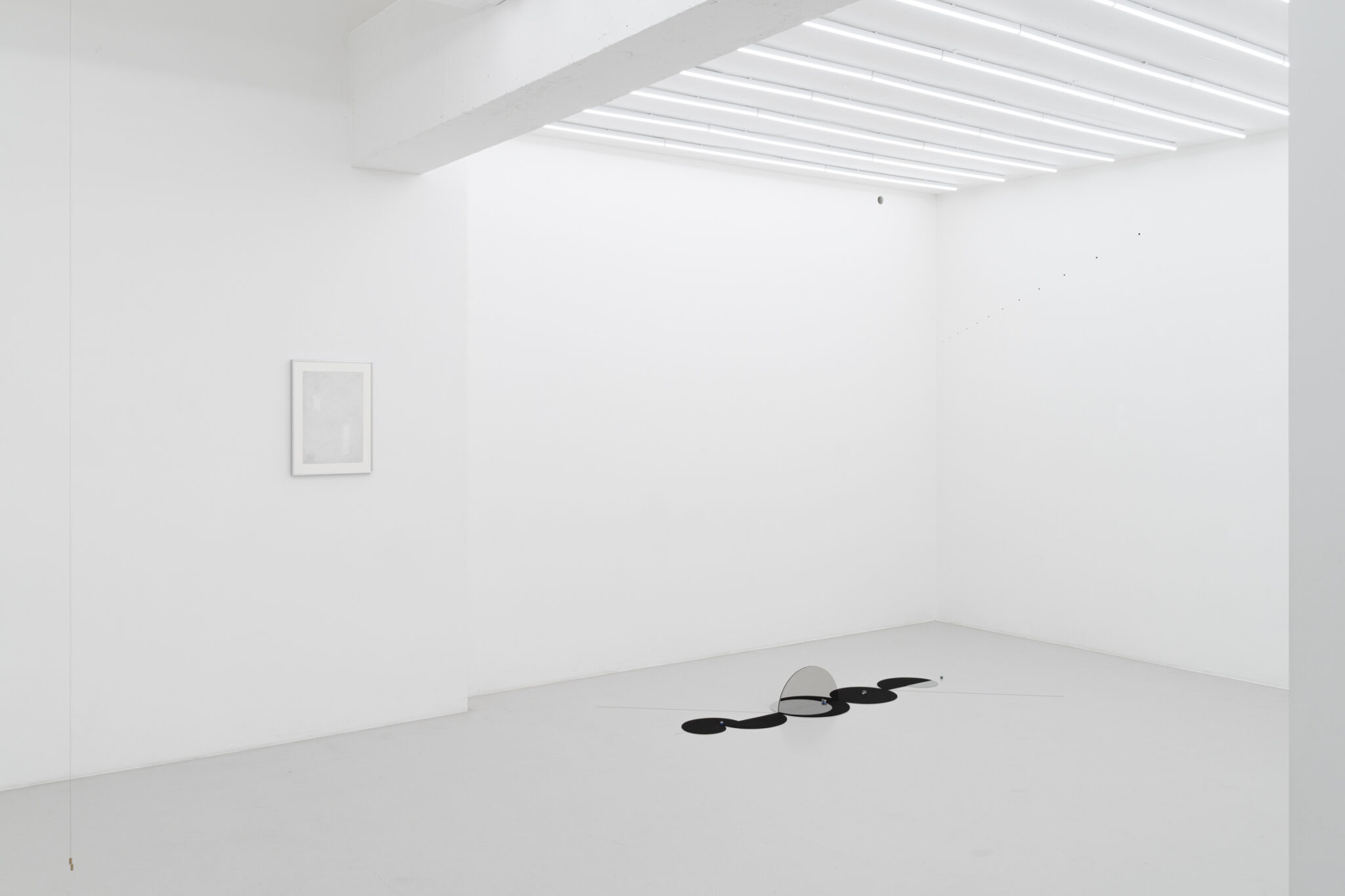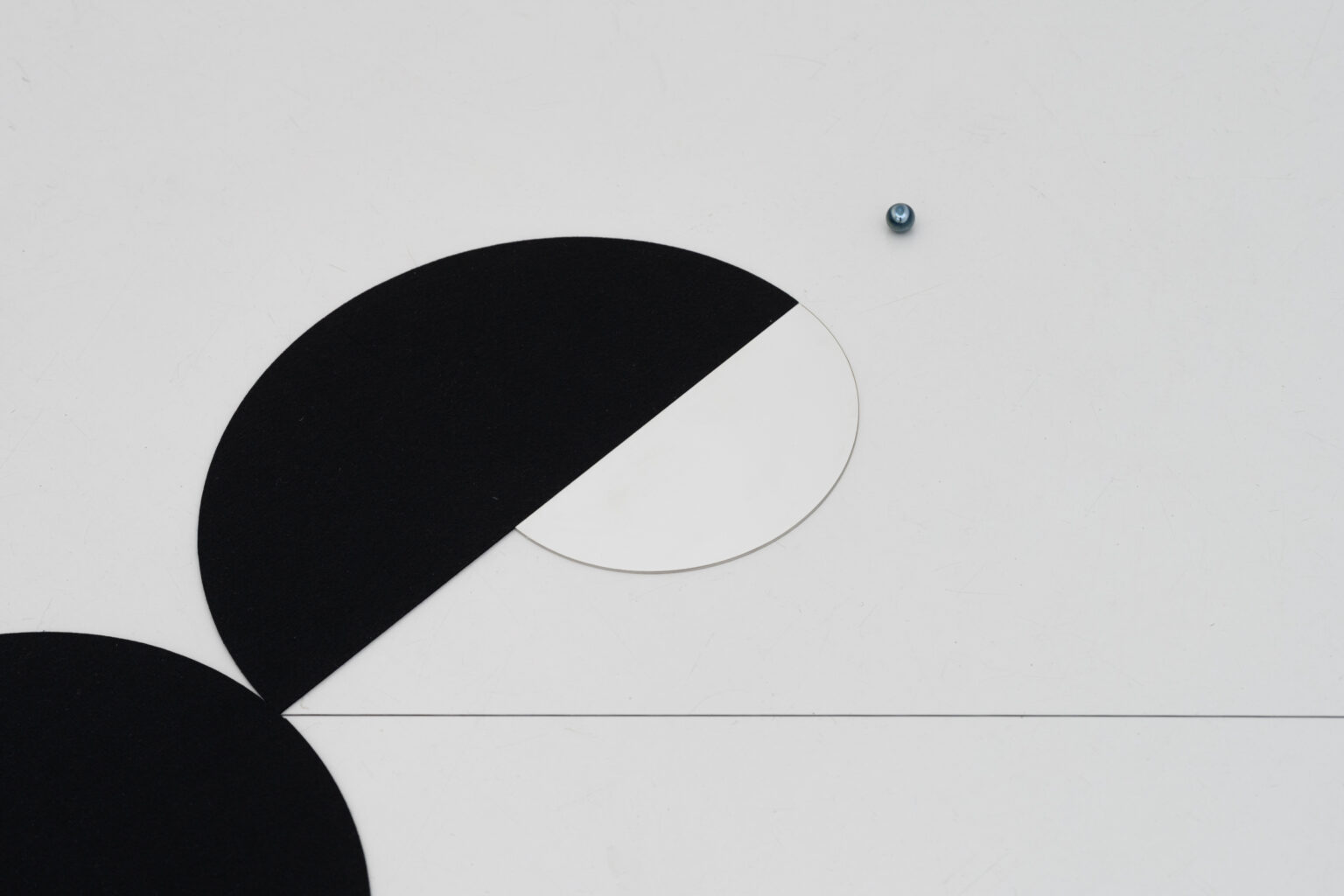Exhibition
Counterforms
카운터폼

INSTALLATION VIEW “Counterforms”, 2025. Courtesy of the Artist and ThisWeekendRoom.
“Counterform” is a term from typography referring to the empty or negative space shaped by a glyph. For instance, it may be the entirely enclosed cavity within the letter “b,” or the partially open void in “n,” an area defined by the contours of a figure yet difficult to name on its own. This space is not merely an absence but can also be understood as a kind of negation that gives presence its meaning. Can a space unoccupied by form take on a compositional role equal to what is visible and material? If form and void, presence and absence, fullness and emptiness define one another, then perhaps the nature of the world can be discerned through the perception of this invisible interval. The exhibition juxtaposes the ways in which Jong Oh and Amber Topilsek each explore the notion of the unseen form. The margins that surround the tangible, the light that grazes the surface of an image, and the faint residues of memory intersect and resonate within a shared space, revealing the outer edges of existence. Through acts of perception and transformation, the two artists ask what has been emptied, and how what is emptied may come to generate meaning. Ultimately, their works unfold as silent shadows that rest upon invisible structures and delicate orders of vision.
Jong Oh sensitively perceives the gravity and weight that create the linear rhythm of structure, engaging with space through acts of subtraction. While contrasts of point, line, and plane are often sustained by a calculated physical balance, he overturns such logic, unfolding instead a strange cosmos of geometry. His works elicit quiet surprise, where the unexpected emerges from what feels familiar. Within the exhibition, viewers may discern two kinds of walls: the “given,” whose back remains unseen, and the “constructed,” whose reverse side is exposed. Historically, walls have divided the political from the personal, the public from the domestic, boundaries that have grown increasingly solid. Yet Oh mimics these partitions with delicate lines, suggesting a brief detachment from one’s own wall, and by extension, from the world or the self upon which one stands.
The artist continually crosses the boundaries between public and private realms, setting a pendulum of illusion into constant motion. He also focuses on moments of tension and balance when materials of differing properties meet, allowing their qualities to be exchanged. Thread, glass, felt, mirror, wire, and light maintain a temporary equilibrium according to his sense of their weight and texture. Rather than occupying space as finished structures, they exist as processes of continual adjustment. Each work becomes a site where micro and macro structures intersect, generating a third, in between form.
Amber Topilsek’s gaze lingers in moments that are never fully complete. The images in her work are often slightly out of focus or seem to have slipped from capture. Photography, formed through differences between what light touches and what it leaves in shadow, is composed of what is revealed and what is concealed. Topilsek considers this not merely a medium for recording but a perceptual instrument that visualizes the unseen density of time. By printing on glass, she evokes presences the image itself cannot contain: the trace of two horses found in a deceased traveler’s notebook (Light Veiled), or the flower of a night blooming cereus (In There).
As both the photosensitive plate of early photography and the screen of contemporary vision, glass holds truth and illusion at once. Its surface, shifting in color and transparency with light and the viewer’s movement, becomes both support and membrane, a boundary across which the gaze glides. The fractured or punctured image plane reflects the artist’s intent to return the limits of vision into something beyond seeing. The indeterminate viewpoint, muted tones, and faint outlines evoke how memory evaporates and flattens over time. Suspended in midair, her images hover between the real and the illusory within an unfixed flow of space and time.
Our environment is composed largely of objects, concrete and individual presences within the material world. Yet today, immaterial entities such as simulations and artificial intelligence increasingly occupy this terrain, as we consume images freely within virtual space. In such conditions, reality seems to have lost its density, and we breathe through transparent, unstable surfaces. Still, even as objects verge on becoming spectral, there remains a persistent urge to grasp what grows lighter, to measure the weight of what can and cannot be touched. Through this, we are reminded that the world can never belong entirely to one side.
Text | Yoosin Lee (Curator, ThisWeekendRoom)

INSTALLATION VIEW “Counterforms”, 2025. Courtesy of the Artist and ThisWeekendRoom.
카운터폼(Counterform)은 타이포그래피 용어로서 형태(form)에 의해 생겨나는 빈 공간 또는 부정된 형태를 의미한다. 예컨대 알파벳 ‘b’의 내부 공간, 혹은 ‘n’의 개방된 공간처럼 형태의 외곽을 따라 형성되지만 그 자체로는 무언라 명명되기 어려운 자리이다. 형태가 차지하지 않은 공간이 시각적으로나 개념적으로 형태와 동등한 역할을 할 수 있을까? 형과 공(空), 몸과 공(空)의 관계처럼 형태와 그 반영이 서로를 정의함에 따라 세계의 모습은 무엇-공간들을 인식함으로써 가능할 수 있을 것이다. 전시는 오종훈과 앰버 토플리섹(Amber Topilsek)이 보이지 않는 형상을 둘러싼 방식을 탐구한다. 이미지의 표면을 스치는 빛, 그리고 기억의 미세한 잔영들 등이 하나의 공간에서 반향처럼 교차하며 존재의 외연을 드러낸다. 두 작가는 투사와 변형의 과정을 통해 무엇이 비워졌는지, 비워진 것이 어떻게 의미를 생성하는지 질문한다. 이윽고 그 결과물은 바꾸처져 구조와 시각적 질서를 담고 선 무언의 음영으로 드리운다.
오종훈은 구조의 성취적 리듬을 만들어내는 중력과 무게감을 섬세히 감지하고 이를 비워내는 방식으로 공간과 관계 맺는다. 본디 점·선·면의 대비는 데이터에 의해 계산된 정련 같은 물리적 균형을 통해 유지되는 반면, 그는 종종 관습적 논리나 질서를 전복하여 예상치 못한 조화의 우주를 펼쳐 놓는다. 그의 작품은 소위 익숙한 것에서 예상치 못한 것을 발견하는, 다소 은밀한 놀라움을 이루어낸다. 이번에 전시장에 관객은 두 종류의 벽을 구분할 수 있다. 하나는 뒤편이 보이지 않는 “주어진” 벽, 다른 하나는 뒷면이 보이는 “만들어진” 벽이다. 역사적으로 벽은 정치적인 것과 사적인 것, 즉 공공적인 것과 일상적인 것을 나누는 경계로써 시간이 지날수록 더욱 견고한 모습으로 발전되어 왔다. 그러나 오종훈은 이를 얇은 두께의 선으로 모방하며 누군가 자신의 벽으로부터, 그래서 어떤 의미로는 한 발 디딘 세상과 자기 자신에게서 보이지 않게 보기를 제한한다.
이처럼 작가는 주변을 둘러싼 고정된 틀을 사적 지대로 원점하여 끊임없이 가상의 추를 움직인다. 동시에 그는 서로 다른 물성이 만나 유발하는 긴장과 안정의 순간에 주목하며 재질 간 성질을 교환시킨다. 거멀, 실, 유리, 펠트, 거울, 철사, 조명 등은 그가 허허 공간에 제질에 따라 일시적 수평을 유지하며, 각 재료와의 구조적·물질적 구성을 공유하기보다 교묘하게 그 균형의 징후를 포착하는 과정 자체로 존재한다. 여기서 각각의 작품은 미시적 구조와 거시적 구조가 교차하는 장소이자 제3의 존재를 생산하는 하나의 현장이 된다.
앰버 토플리섹의 시선은 언제나 미완의 회한에 머문다. 화면 속 상들은 흐릿한 초점이 맞닿거나 갖거나 작품 작업의 일탈로 인해 잊혀졌다. 저지대에서의 사진은 빛이 닿은 부분과 닿지 않은 부분의 차이가 기포로 생성된다. 다시 말해 노출과 명암, 즉 빛과 그림자의 구조에 의해 빛에 의해 사라지거나 동시에 가려지는 것들을 구성된다. 토플리섹의 이를 대상을 기록하는 매체를 넘어서 보이지 않는 시간의 밀도를 시각화하는 장치로 여기고, 유리라는 매개체에 새겨 이미지가 담지하지 못한 사라진 존재를 환기한다. 그가 불러오고자 하는 것은 작고 잔여 여부 여행 속에서 발견한 말 두마리 흔적(Light Veiled), 한밤중에 피어나는 세레우스 선인장의 꽃(In There)처럼 직접 보지 못한 것의 남겨진 잔상임에 다름 아니다.
한편, 유리는 사진의 감광판이자 현대 시각 경험을 구성하는 스마트 스크린으로서 우리는 그것을 동시에 품는다. 빛과 관람자의 움직임에 따라 색과 투명도가 변화하는 표면은 지지체 또는 막(膜)이 동시에 시선이 미끄러지는 경계가 되고, 불투명하게 조각나거나 구멍이 뚫린 화면은 유리를 보는 범위를 한계로부터 송시계하는 작가의 의지를 내포한다. 더욱이 불분명한 시점, 흐릿한 선들, 희미한 형상들은 기억의 증발하고 납작하게 되는 과정을 닮은 면모를 지닌다. 저 또한 유리 화면에 중부로 떠 있는 이미지들은 실재적과 환영성이 뒤엉킨 공간과 시간의 흐름 속에서 어딘가에 부유한다.
환경은 대부분 사물로 이루어져 있다. 사물은 물질세계에 있는 모든 구체적인 개별적 존재를 형상한다. 아먼 오늘날 우리는 시뮬레이션이나 인공지능 같은 비사물이 물질의 존재 방식을 채워지고, 이제 우리는 가상의 공간 속에서 서성이며 이미지가 대상과 떠난 것의 가치를 헤아려 보 는 것이다. 여전히 세상은 한쪽에만 오롯이 치우쳐지 않는다는 사실을 깨닫는다.
글 | 이유진 (디스위켄드룸 큐레이터)

INSTALLATION VIEW “Counterforms”, 2025. Courtesy of the Artist and ThisWeekendRoom.
2025. 11. 08. (Sat) – 2025. 12. 06. (Sat)
ThisWeekendRoom